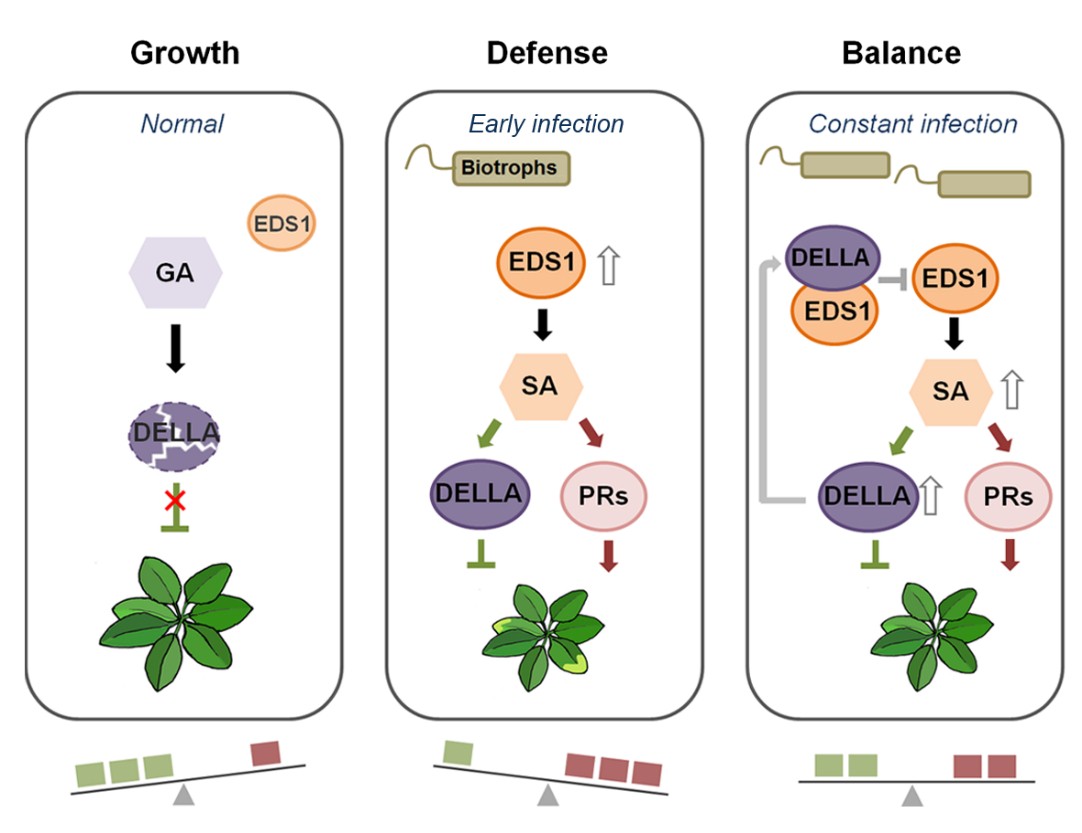
Due to internal resource restriction, plants have evolved an elaborate regulatory mechanism to modulate the tradeoff between growth and defense for survival under external stress. When attacked by pathogenic bacteria or insect pests, plants often devote more resource to activate defense response at the expense of growth. That is so called “tradeoff” between growth and defense.
Previous studies have extensively reported the growth-defense tradeoff in plants and partially illuminated its regulatory mechanism. However, most of them only focused on how plants initiate the growth-defense tradeoff and paid less attention to its subsequent regulatory process.
If plants reallocate resource to enhance resistance without restriction, growth and development would be arrested, even cause death. This brings us a question: how plants modulate the balance between meeting the necessary growth and achieving maximum resistance? The underlying mechanism remains unclear.
Recently, in a new study entitled "DELLA and EDS1 Form A Feedback Regulatory Module to Fine-tune Plant Growth-Defense Tradeoff in Arabidopsis" published in Molecular Plant, HOU Xingliang's research group from South China Botanical Garden of the Chinese Academy of Sciences reported the latest research progress on the precise regulation of growth-defense balance in plants.
DELLA protein is a key negative regulator of gibberellin (GA) signaling pathway, which functions in many aspects of plant growth and development, and also participates in the regulation of plant stress response.
In this study, it was found that DELLA protein could interact with EDS1, a key plant disease resistance factor, by a yeast two-hybrid screening. In the presence of EDS1, Pst DC3000 and salicylic acid (SA) could antagonize the GA-triggered degradation of DELLA protein, thus suppressing plant growth. DELLA could impair the binding of EDS1 to downstream target promoter to reduce the expression of disease-resistant genes.
Together, through a series of molecular, biochemical, and genetic evidence, this study reveals the key role of DELLA-EDS1 module in regulating plant growth-defense balance, and proposed a hypothetical regulatory model (Figure): DELLAs maintain low abundance in plants via GA-triggered degradation during the dominant growth stage; When plants are infected by pathogens, the essential resistance regulator EDS1 is rapidly induced, which directs SA biosynthesis and the consequent resistance-related gene expression to prime/amplify the defense response.
Significant SA accumulation stabilizes DELLA proteins to restrain growth, probably for resource reallocation to prioritize resistance (tradeoff). Defense is dominant during this stage; Along with infection or disease development, the increased stabilized DELLAs in turn interact with the EDS1 protein to suppress SA overproduction and excessive resistance response.
Through this negative feed-back regulatory loop, plants can maintain the subtle balance between growth and defense to avoid immoderate growth or defense in response to pathogen attack.

Figure. A negative regulatory loop in modulating the balance of plant growth and defense against pathogen (Image by SCBG)
It is well known that plant diseases often cause significant loss of crop yield. Conventional breeding has found that varieties with high resistance to disease are usually accompanied by low yield. To growth, or to defense, that is an important issue. In this study, the DELLA member RGL3 was found to inhibit plant growth only under external stress, thus providing a possible solution to promote plant disease resistance with minor impact on normal growth.

86-10-68597521 (day)
86-10-68597289 (night)

86-10-68511095 (day)
86-10-68512458 (night)

cas_en@cas.cn

52 Sanlihe Rd., Xicheng District,
Beijing, China (100864)

